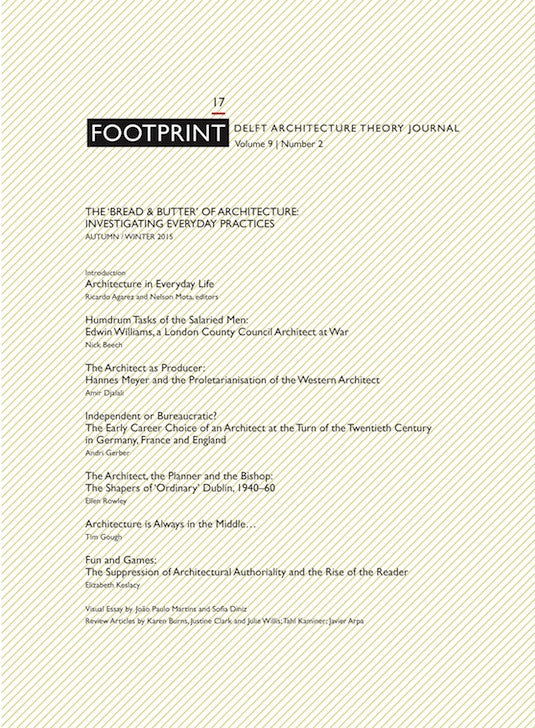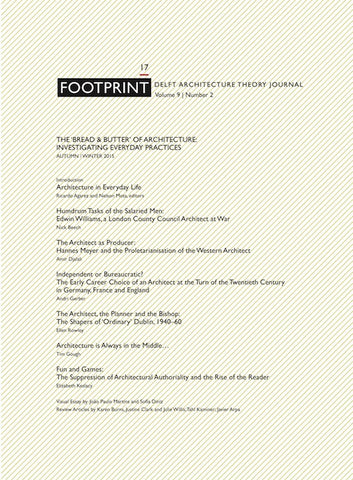Your cart is currently empty!
Architecture
Footprint 17 Vol 9/2 The 'Bread & Butter'of Architecture
+++Investigating Everyday Practices+++
+++Nelson Mota, Ricardo Agarez [eds.]+++
978-94-90322-61-8
Meagen Kerr
184
19 x 25.7 cm
Paperback
English
Copy editor: Heleen Schröder
Release date: Autumn/Winter 2015
Published in cooperation with Architecture Theory Chair (TU Delft) and Stichting Footprint: http://footprint.tudelft.nl/
For a subscription: Bruil & Van de Staaij
The canon of western contemporary architecture has overlooked everyday, 'salaried' architecture – overwhelming as it may have turned out to be in our built environment – praising instead the solo designer and his ground-breaking work.
Since World War I, the social role of the architect (in terms both of his or her place in social hierarchies and of his or her contribution for social betterment) seems to have been primarily tested, and largely consolidated, in 'departmental architecture'. Yet the work of county, city and ministerial architects, heads of department in welfare commissions, guilds and cooperatives, is seldom discussed as such: its specificity as the product of institutional initiatives and agents, as the outcome of negotiation between individual and collective agendas, remains little explored, even when authors celebrate the many public-designed projects that are part of the canon. On the other hand, commercially driven architecture and the business side of the profession are still anathema for many, despite being essential factors in the discipline's position in society.
Footprint 17 addresses the architectural production of those who played their part in inconspicuous offices and unexciting departments, and that contribute insights to discuss the place of the architecture of 'bread & butter' in architectural history studies and in the politics of architectural design and theory.
This issue of Footprint explores intellectual frameworks, didactic practices, research methods and analytical instruments that project the disciplinary focus further than the work of the 'prime mover', discussing the relevance of 'salaried' architects and institutional agency in shaping the spatial and social practices of the everyday.
With text contributions by: Ricardo Agarez, Nelson Mota (editors), Nick Beech, Amir Djalali, Andri Gerber, Ellen Rowley, Tim Gough, Elizabeth Keslacy. A visual essay by João Paulo Martins, Sofia Diniz. And review articles by Karen Lisa Burns, Justine Clark, Jullie Willis; Tahl Kaminer; Javier Arpa.
Footprint is an academic journal dedicated to publishing architecture and urban research. Architecture and urbanism are the points of departure and the core interests of the journal. From this perspective, the journal encourages the study of architecture and the urban environment as a means of comprehending culture and society, and as a tool for relating them to shifting ideological doctrines and philosophical ideas. The journal promotes the creation and development – or revision - of conceptual frameworks and methods of inquiry. It is engaged in creating a body of critical and reflexive texts with a breadth and depth of thought which would enrich the architecture discipline and produce new knowledge, conceptual methodologies and original understandings.
Investigating Everyday Practices
€25.00
Footprint 17 Vol 9/2 The 'Bread & Butter'of Architecture
Investigating Everyday Practices
€25.00
Architecture / Bookazines / Series / Theory
978-94-90322-61-8
Meagen Kerr
184
19 x 25.7 cm
Paperback
English
Copy editor: Heleen Schröder
Release date: Autumn/Winter 2015
Published in cooperation with Architecture Theory Chair (TU Delft) and Stichting Footprint: http://footprint.tudelft.nl/
For a subscription: Bruil & Van de Staaij
The canon of western contemporary architecture has overlooked everyday, 'salaried' architecture – overwhelming as it may have turned out to be in our built environment – praising instead the solo designer and his ground-breaking work.
Since World War I, the social role of the architect (in terms both of his or her place in social hierarchies and of his or her contribution for social betterment) seems to have been primarily tested, and largely consolidated, in 'departmental architecture'. Yet the work of county, city and ministerial architects, heads of department in welfare commissions, guilds and cooperatives, is seldom discussed as such: its specificity as the product of institutional initiatives and agents, as the outcome of negotiation between individual and collective agendas, remains little explored, even when authors celebrate the many public-designed projects that are part of the canon. On the other hand, commercially driven architecture and the business side of the profession are still anathema for many, despite being essential factors in the discipline's position in society.
Footprint 17 addresses the architectural production of those who played their part in inconspicuous offices and unexciting departments, and that contribute insights to discuss the place of the architecture of 'bread & butter' in architectural history studies and in the politics of architectural design and theory.
This issue of Footprint explores intellectual frameworks, didactic practices, research methods and analytical instruments that project the disciplinary focus further than the work of the 'prime mover', discussing the relevance of 'salaried' architects and institutional agency in shaping the spatial and social practices of the everyday.
With text contributions by: Ricardo Agarez, Nelson Mota (editors), Nick Beech, Amir Djalali, Andri Gerber, Ellen Rowley, Tim Gough, Elizabeth Keslacy. A visual essay by João Paulo Martins, Sofia Diniz. And review articles by Karen Lisa Burns, Justine Clark, Jullie Willis; Tahl Kaminer; Javier Arpa.
Footprint is an academic journal dedicated to publishing architecture and urban research. Architecture and urbanism are the points of departure and the core interests of the journal. From this perspective, the journal encourages the study of architecture and the urban environment as a means of comprehending culture and society, and as a tool for relating them to shifting ideological doctrines and philosophical ideas. The journal promotes the creation and development – or revision - of conceptual frameworks and methods of inquiry. It is engaged in creating a body of critical and reflexive texts with a breadth and depth of thought which would enrich the architecture discipline and produce new knowledge, conceptual methodologies and original understandings.



